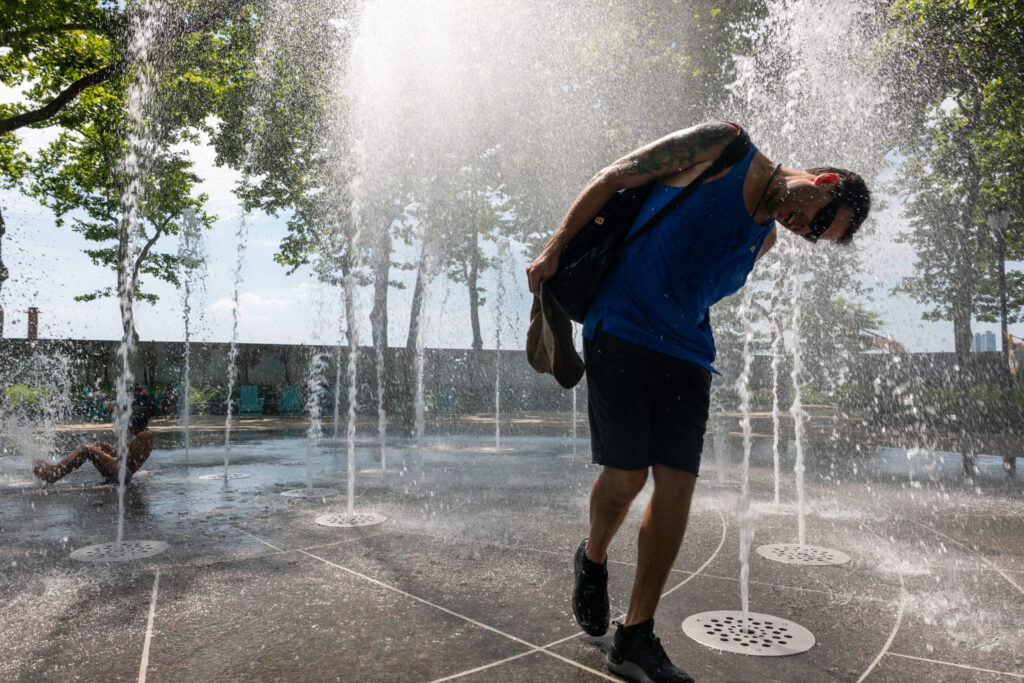A man cools off in a fountain in Manhattan on a sweltering afternoon on the first day of summer on June 20, 2024 in New York City. The average daily high in Charleston, W.Va., in the second half of June and the entire months of July and August was 90 degrees.(Spencer Platt | Getty Images)
It brings me sincere joy to write the next sentence. After what felt like a summer full of heat advisories, It’s finally cooling down. The average daily high in Charleston in the second half of June and the entire months of July and August was 90 degrees. And it’s been a dry summer, with a severe, widespread drought hitting most of the state. But this week it looks like we won’t hit 90 at all.
In my first commentary last year for West Virginia Watch, I wrote about how the wildfire smoke that blanketed skies on the East Coast last summer could hopefully serve as a signal for people who are unable or reluctant to see the impacts of climate change around them. Though we’re not immune to flooding and other environmental harms and disasters in West Virginia, climate skeptics rarely see these events for what they are: the consequences of climate change and our systemic failure to address them.
This summer I think the most obvious illustration of these consequences has been the twin challenges of heat waves and the persistent drought that most of West Virginia has experienced in recent months.
And somewhat optimistically, I hope that because heat and drought have real, tangible impacts on people’s day-to-day lives — and the fact they could become more frequent in coming years — these consequences will make us more likely to take the actions necessary to build a more climate-resilient society. Or, if nothing else, at least talk about these challenges more openly.
Steps to prepare West Virginians for frequent, extreme heat are needed and could be the difference between life and death. A recent study found that heat-related deaths have more than doubled in the United States over the last couple decades. That sobering statistic hit close to home for me this year. Just a day into the first heat wave of the summer, I received a text letting me know that a relative died in the Eastern Panhandle while working an outside construction gig.
When temperatures do approach such extreme highs, weather services and local governments issue advisories. They’re important, but these warnings are reactive and focus on the personal. Make sure your air conditioner works. Check on your elderly relatives. Stay indoors if you can. Go to a cooling center if they happen to be open.
But what if you live in old, inefficient housing like many in Appalachia do, and your heating and cooling works so poorly that it seems like they’re barely on? (On high, my two window units couldn’t get my apartment below 85 degrees at points this summer.) On top of that, inefficient heating and cooling contributes to ever-increasing power or gas bills, in part thanks to a Public Service Commission that does not have West Virginians’ best interest at heart.
Or what if you’re an elderly person with few connections who can check on you? Or a person who doesn’t have the luxury of a job that keeps them inside and you must work outside like my relative did?
These warnings are not and have not been enough to prevent the rise in heat-related deaths in the country. We need to do more to beat the heat, especially given that temperatures are rising. The ten hottest years ever recorded were all in the last decade, and scientists expect it to get worse over the next decade.
Federal and state governments can encourage localities to build modern, energy efficient housing. States should adopt building codes that ensure builders will follow through. State and local governments, and yes the PSC, should adopt policies that both encourage and subsidize energy efficiency upgrades. Something as small as improving attic insulation or replacing a few leaky windows could make several degrees of difference.
At the local level, creating more green space in our cities will not only beautify them, but also add shade that lowers temperatures. Some cities have even created official positions whose responsibilities include identifying strategies to protect residents from heat. At the federal level, the Biden Administration recently proposed a rule intended to protect workers from extreme heat.
When it comes to power bills, running the AC can come with a high cost. In West Virginia where our energy supply is about 90% coal-powered, that cost hits our wallets but also contributes to the climate crisis. Ensuring that more West Virginians can live in safer, energy efficient homes means we’ll save money and reduce our climate impact.
We need to accept that, despite what felt like endless days of 90-plus degree weather, this may be the coldest summer we’ll have for the rest of our lives and some people — too many, including my relative — weren’t afforded the tools or protections they needed to survive it. As it gets hotter and hotter each year, the reality is any of us could be one of those people.
We need the government and its leadership to accept this reality and make policy decisions that don’t just allow us to survive — sweating, dehydrated and sick from the sun — but allow us to thrive. We need them to acknowledge the facts sitting right in front of them: climate change is real, its consequences are here and will continue coming for all of us. Selling us out for corporate interests and favor won’t matter a bit over the next few decades as we see these impacts get more and more severe, leaving thousands to die — from natural disasters, heat stroke and more — from governmental inaction.
GET THE MORNING HEADLINES DELIVERED TO YOUR INBOX

